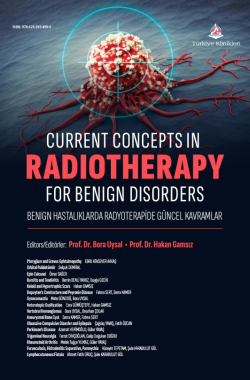Vertebral Hemangiomas
Bora UYSALa , Onurhan ÇOLAKb
aUniversity of Health Sciences Gülhane Faculty of Medicine, Department of Radiation Oncology, Ankara, Türkiye
bBatman Training and Research Hospital, Clinic of Radiation Oncology, Batman, Türkiye
Uysal B, Çolak O. Vertebral hemangiomas. In: Uysal B, Gamsız H, eds. Current Concepts in Radiotherapy for Benign Disorders. 1st ed. Ankara: Türkiye Klinikleri; 2025. p.38-42.
ABSTRACT
Vertebral hemangiomas are benign tumors of the vertebrae. It is present in 10-28% of the population. It is approximately 1.5 times more likely to occur in women than in men. They are usually asymptomatic and are diagnosed incidentally. These asymptomatic cases often do not require intervention. Those that cause back pain, fractures, bleeding and neurological deficits require intervention. Radiotherapy is a safe and effective treatment option and stands out as being non-invasive. Radiotherapy can be used definitively or in combination with other options. Adjuvant radiotherapy may be recommended for patients undergoing subtotal surgical resection for aggressive vertebral hemangioma. In conventional fractionation, a total dose of 36-40 Gy is very effective in providing disease control and pain palliation. Hypofractionated Stereotactic treatments can also be applied successfully.
Keywords: Spine; hemangioma; radiotherapy; vascular neoplasms; bone diseases
Kaynak Göster
Referanslar
- Hameed M, Bloem JL, Righi A. Haemangioma of bone. in: WHO Classification of Tumours Editorial Board, eds. Soft tissue and bone tumours. World Health Organization e, International Agency for Research on Cancer. 5th ed. Lyon (France): International Agency for Research on Cancer; 2020. p.426-7.
- McAllister VL, Kendall BE, Bull JW. Symptomatic vertebral haemangiomas. Brain. 1975;98(1):71-80. [Crossref] [PubMed]
- Kasch R, Scheele J, Hancock M, Hofer A, Maher C, Bülow R, et al. Prevalence of benign osseous lesions of the spine and association with spinal pain in the general population in whole body MRI. plos one. 2019;14(9):e0219846. [Crossref] [PubMed] [PMC]
- Murugan L, Samson RS, Chandy MJ. Management of symptomatic vertebral hemangiomas: review of 13 patients. Neurol India. 2002;50(3):300-5.
- Hoyle JM, layfield LJ, Crim J. The lipid-poor hemangioma: an investigation into the behavior of the "atypical" hemangioma. Skeletal Radiology. 2020;49(1):93-100. [Crossref] [PubMed]
- Enneking WF. Musculoskeletal tumor staging: 1988 update. In: Pinedo HM, Verweij J, eds. Treatment of Soft Tissue Sarcomas. Boston, MA: Springer US; 1989. p.39-49. [Crossref] [PubMed]
- Jawad MU, Scully SP. In Brief: Classifications in Brief: enneking Classification: Benign and Malignant Tumors of the Musculoskeletal System. Clinical Orthopaedics and Related Research®. 2010;468(7). [Crossref] [PubMed] [PMC]
- Sharma S, Kamal R, Rathi AK. Vertebral hemangioma - the current radiation therapy perspective. Rep Pract Oncol Radiother. 2023;28(1):93-101. [Crossref] [PubMed] [PMC]
- Diarra MD, Zhang Z, Wang Z, Yinwang E, Li H, Wang S, et al. Surgical Options for Aggressive Vertebral Hemangiomas: A case series, literature review and treatment recommendations. J Bone Oncol. 2023;43:100515. [Crossref] [PubMed] [PMC]
- Goldstein CL, Varga PP, Gokaslan ZL, Boriani S, Luzzati A, Rhines L, et al. Spinal hemangiomas: results of surgical management for local recurrence and mortality in a multicenter study. Spine (Phila Pa 1976). 2015;40(9):656-64. [Crossref] [PubMed]
- Acosta FL Jr, Sanai M, Chi JH, Dowd CF, Chin C, Tihan t, et al. Comprehensive management of symptomatic and aggressive vertebral hemangiomas. Neurosurg Clin N Am. 2008;19(1):17-29. [Crossref] [PubMed]
- Tomasian A, Wallace AN, Jennings JW. Benign spine lesions: Advances in techniques for Minimally invasive percutaneous treatment. AJNR Am J Neuroradiol. 2017;38(5):852-61. [Crossref] [PubMed] [PMC]
- Seegenschmiedt MH, Brady LW, Heilmann HP, Makoski HB, Trott KR, Molls M, et al. Radiotherapy for Non-Malignant Disorders: Springer Berlin Heidelberg; 2009. [Crossref]
- Heyd R, Seegenschmiedt MH, Rades D, Winkler C,Eeich HT, Bruns F, et al. Radiotherapy for symptomatic vertebral hemangiomas: results of a multicenter study and literature review. int J Radiat Oncol Biol Phys.2010;77(1):217-25. [Crossref] [PubMed]
- Rades D, Bajrovic A, Alberti W, Rudat V. Is there a dose-effect relationship for the treatment of symptomatic vertebral hemangioma? Int J Radiat Oncol Biol Phys. 2003;55(1):178-81. [Crossref] [PubMed]
- Conti A, Starnoni D, Barges-Coll J, Papadimitriou K, Levivier M, Tuleasca C. Radiosurgery for Benign Vertebral Body Hemangiomas of the Spine: A Systematic Review and Meta-Analysis. World Neurosurg. 2022;164:97-105. [Crossref] [PubMed]
- Miszczyk M, Napieralska A, Woźniak g, Kraszkiewicz M, Gola M, Kalemba M, et al. Conventionally fractionated radiotherapy versus CyberKnife hypofractionated radiotherapy for painful vertebral haemangiomas - A randomized clinical trial. Radiother Oncol. 2022;176:46-52. [Crossref] [PubMed]
- Uysal B, Gamsiz H, Dincoglan F, Sager O, Demiral S, Dirican B, et al. Singlecenter outcomes of image-guided radiotherapy in the management of vertebral hemangioma with daily kilovoltage cone-beam computerized tomography. J Cancer Res Ther. 2021;17(6):1521-4. [Crossref] [PubMed]
- Beyzadeoglu M, Dirican B, Oysul K, Surenkok S, Pak Y. Evaluation of radiation carcinogenesis risk in vertebral hemangioma treated by radiotherapy. Neoplasma. 2002;49(5):338-41.

